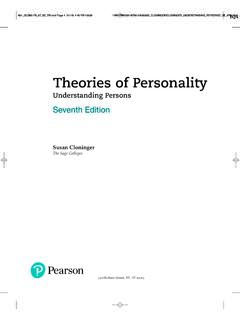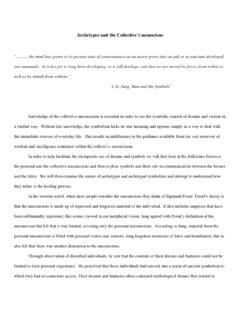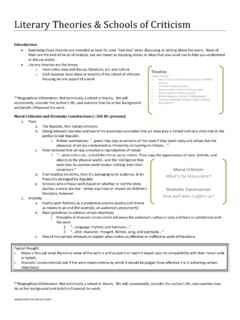Transcription of Jung's Map of the Soul - Planète Corée
1 Table of Contents Title PageDedicationAcknowledgementsIntroducti on Chapter 1 - Surface:The Relation of Ego to ConsciousnessThe Location of the EgoPsychological TypesPersonal Freedom Chapter 2 - The Populated InteriorReaching the UnconsciousThe ComplexesLevels of the UnconsciousPsychic ImagesPersonality FragmentsThe Structure of ComplexesThe Eruption of Complexes Chapter 3 - Psychic EnergySexuality and LibidoThe Transformation of Psychic EnergyPhysics as a ModelThe Source of EnergyMeasurement of Psychic EnergyThe Unity of Body and MindEnergy, Movement, and DirectionTransformations and Symbols Chapter 4 - The Psyche s BoundariesArchetypes (Psychic Universals)The UnconsciousInstinctsThe Relationship between Archetypes and Instincts Chapter 5 - The Revealed and the Concealed in Relations with OthersThe Ego s ShadowThe Making of the ShadowThe PersonaThe Two Sources of the PersonaPersona DevelopmentThe Persona s TransformationsIntegrating Persona and Shadow Chapter 6 - The Way to the Deep InteriorDefining Anima and AnimusGender and Anima and AnimusThe Development of the Anima/usRaising Consciousness with Anima/usSexuality and Relationships Chapter 7 - The Psyche s Transcendent Center and WholenessJung s Experience of the SelfJung s Definition of the SelfSymbols of the SelfThe Self as Central Mystery of the Psyche Chapter 8 - Emergence of the SelfThe Psychological LifespanIndividuationThe Five Stages of ConsciousnessA Case Study in IndividuationThe Movements of the Self Chapter 9 - Of Time and EternityPatterns in ChaosDeveloping the Idea of
2 SynchronicitySynchronicity and CausalitySynchronicity and Archetypal TheoryMind and MatterAbsolute KnowledgeA New ParadigmCosmology NotesGlossaryReferencesIndexCopyright PageFor Sarah and ChristopherAcknowledgmentsThis book would not have been possible without the patient typing andeditorial assistance of Lynne Walter. I want to thank her for her dedication andunflagging optimism. I would also like to thank Jan Marlan for herencouragement and enthusiastic support. Those who have sat through mylectures over the years will recognize their contributions in the many points ofdetail that would not be in this text but for their questions and to all of could timidly explore thecoasts of Africa to the south,but going west there was nothingexcept fear, the unknown, not our sea but the Sea of Mystery,Mare FuentesThe Buried Mirror The summer jung died, I was preparing to go to college.
3 It was 1961. Humanswere beginning to explore outer space, and the race was on to see who wouldbe the first to reach the moon, the Americans or the Russians. All eyes werefocused on the great adventure of space exploration. For the first time inhuman history, people were succeeding in leaving terra firma and travelingtoward the stars. What I did not realize at the time was that our century hasbeen marked just as decisively by the journeys inward, the great explorationsof the inner world undertaken by the likes of Carl jung in the decades beforeSputnik and Apollo. What John Glenn and Neil Armstrong have meant to usas explorers of outer space, jung signifies with regard to inner space, acourageous and intrepid voyager into the died peacefully in his house just outside Zurich, in a room that facedthe calm lake to the west. To the south one could see the Alps. The day beforehe passed away he asked his son to help him to the window to take a last lookat his beloved mountains.
4 He had spent a lifetime exploring inner space anddescribing what he found there in his writings. By coincidence it happenedthat the year Neil Armstrong stepped onto the surface of the moon I embarkedon a journey to Zurich, Switzerland to study at the jung Institute. What I amsharing in this volume is the distillation of nearly thirty years of studyingJung s map of the aim of this book is to describe jung s findings as he presented them inhis published writings. First discovering jung can itself be something likeplunging into that Sea of Mystery written about by Fuentes in his accountof earlier explorers who ventured across the Atlantic from Spain. It is with asense of excitement, but also fear, that one launches out into these far-reaching places. I remember my first attempts. I was swept away by so muchexcitement at the prospect that I anxiously sought the advice of several of myuniversity professors.
5 I wondered if this was safe. jung was so attractivethat he seemed too good to be true! Would I become lost, confused, misled?Luckily for me, these mentors gave me the green light, and I have beenjourneying and finding treasures ever s own original journey was even more frightening. He literally had noidea if he was going to find a treasure or fall over the edge of the world intoouter space. The unconscious was truly a Mare Ignotum when he first lethimself into it. But he was young and courageous, and he was determined tomake some new discoveries. So away he often referred to himself as a pioneer and explorer of the unchartedmystery that is the human soul. He seems to have had an adventuresomespirit. For him as for us still the human psyche was a vast territory, and inhis day it had not yet been much studied. It was a mystery that challenged theadventuresome with the prospect of rich discovery and frightened the timidwith the threat of insanity.
6 For jung the study of the soul also became a matterof grave historical importance, for, as he once said, the whole world hangs ona thread and that thread is the human psyche. It is vital that we all becomemore familiar with great question is, of course: Can the human soul ever be known, itsdepths plumbed, its vast territory charted? It was perhaps some leftovernineteenth-century scientific grandiosity that led early pioneers of depthpsychology like jung and Freud and Adler ever to undertake this effort and tothink that they could define the ineffable and the supremely inscrutablehuman psyche. But set out into this Mare Ignotum they did, and jung becamea Christopher Columbus of the inner world. The twentieth century has beenan age of scientific breakthroughs and technological wonders of all kinds; ithas also been an age of deep introspection and probing into our commonhuman subjectivity, which have resulted in the field broadly known today asdepth way to familiarize ourselves with the psyche is to study the maps of itthat have been drawn up and made available by these great pioneers.
7 In theirworks we can find many points of orientation for ourselves, and perhaps wetoo will be stimulated to carry out further investigations and to make newdiscoveries. jung s map of the psyche, as preliminary and perhaps unrefinedand open-ended as it is as are all first attempts at charting unknownterritories can still be a great boon to those who want to enter inner space,the world of the psyche, and not lose their way this book, I accept jung in his self-designated role of explorer andmapmaker, and I let this image guide me in presenting this introduction to histheory of the human psyche. The psyche is the territory, the unknown realmhe was exploring; his theory is the map he created to communicate hisunderstanding of the psyche. So it is jung s map of the soul that I will attemptto describe in this book by leading you, the reader, into and through theterritory of his writings.
8 In doing so, I am presenting a map of a map, but onethat I hope will be useful to you in your own further journeys into jung s lifeand all mapmakers, jung worked with the instruments and evidenceavailable to him in his time. Born in 1875, he completed his basic medicalstudies at the University of Basel in Switzerland by 1900 and his psychiatrictraining at the Burgh lzli Klinik in Zurich by 1905. His important associationwith Freud extended from 1907 to 1913, after which he spent some years in adeep self-analysis and then emerged with his own distinctive psychologicaltheory called analytical psychology which he presented to the world in1921 in the book Psychological By 1930, aged 55, he had createdmost of the basic features of his theory but had not yet detailed a number ofimportant items. The details would be presented in the years following 1930and would continue to flow from jung s pen until he died in project of exploring the human psyche scientifically was begun earlyin jung s adult life.
9 His first official expedition is described in his doctoralstudy, On the Psychology and Pathology of So-Called Occult gives a psychological account of the inner world of a gifted youngwoman whom we now know was actually his own cousin, Helene a teenager, she had the unusual ability to act as a medium for spirits of thedead, who would speak through her in remarkably accurate historical voicesand accents. jung was fascinated and set out to understand and interpret thispuzzling psychological phenomenon. Pressing ahead, he used the wordassociation test to uncover hidden features of the psychic landscape that hadnot been classified before. These were published in numerous papers, whichare now housed in Volume 2 of his Collected Works. The newly discoveredfeatures of the unconscious he named complexes, a term that would stickand make him famous. After that, he took up two burning psychiatricproblems of the day, psychosis and schizophrenia, and produced a book, ThePsychology of Dementia Praecox, 3 which he sent to Freud as an example ofhis work and as a suggestion for how some of Freud s ideas could be appliedin psychiatry (Freud was a neurologist).
10 After receiving Freud s warm andenthusiastic response, he entered into a professional relationship with him andquickly became the leader of the fledgling psychoanalytic movement. Withthis he began his study of the shadowy regions of neurotic conditions, landingfinally on the discovery of more or less invariant universal fantasies andpatterns of behavior (the archetypes) in an area of the deep psyche that hecalled the collective unconscious. The description and detailed account ofthe archetype and the collective unconscious would become his signature, amark that sets his map apart from those of all other explorers of the deeppsyche, the year 1930 divides jung s professional life almost exactly in half: in1900 he began his training and psychiatric studies at the Burgh lzli Klinik,and in 1961 he died a wise old man in his home at K snacht on Lake Z retrospect, one can see that jung s first thirty years of professional activitywere profoundly creative.







